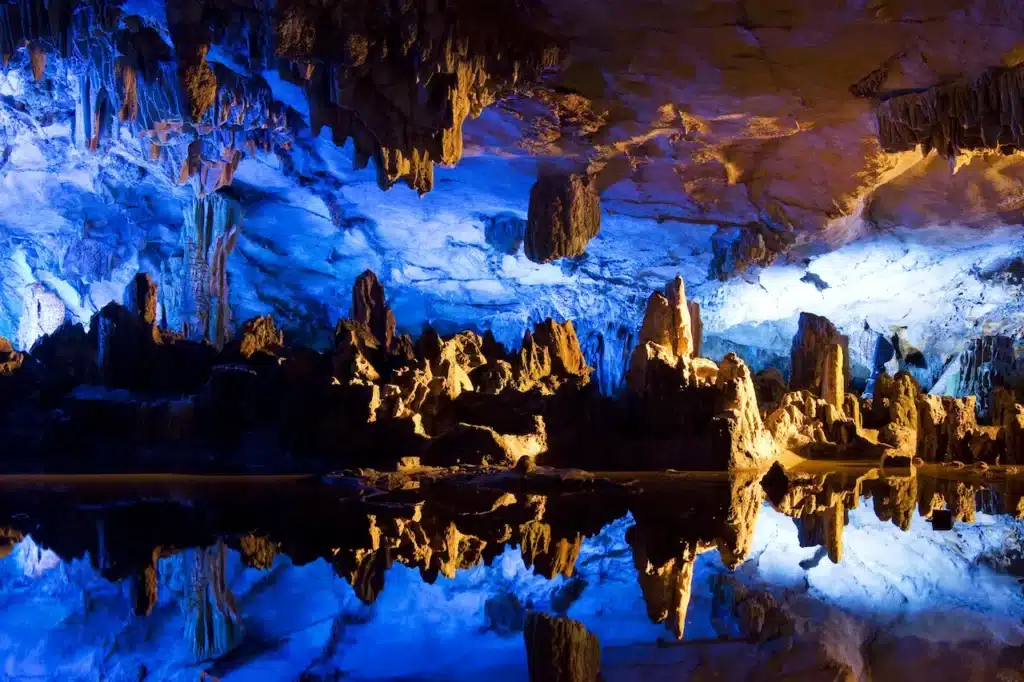Mystery Caves of Guangxi
Mystery Caves of Guangxi: A Geographic Journey to China's Underground Wonders
The Guangxi Autonomous Region is located in southern China. Guangxi is known for its limestone karsts, emerald green rivers and dramatic surface geography. But that’s just the beginning. Under the misty hills and mountains, hundreds of mysterious caverns lie. These hidden labyrinths tell stories of geological time, ancient human presence, eco-adaptation, and nature’s sheer power.
These caves are much more than just tourist attractions or archeological wonders. These caves are a rich tapestry expressing geological processes, as well as the internal architecture of Earth, which is shaped by time, water and tectonics.
This blog will take readers on a journey through the Mystery Caves of Guangxi, where stone and shadow combine to create one of Asia’s most intriguing underground landscapes.
The Karst Topography in Guangxi
To understand the caves in Guangxi, one must first be familiar with the karst terrain. Karst topography is formed by the dissolution and movement of soluble rock, like dolomite or gypsum. Guangxi is dominated geologically by large deposits of limestone, which formed 300 million years ago when the area was covered with a shallow tropical ocean.

Rainwater, slightly acidic due to dissolved carbon dioxide, began to seep through cracks in limestone over millions of years. This led them gradually to grow. The chemical weathering created the vast network of sinkholes and caves that characterise Guangxi’s subterranean landscape today.
Guangxi forms part of the larger South China Karst. This UNESCO World Heritage Site is known for its dramatic cliffs and pinnacles as well as underground systems. The caves of Guangxi are both cultural and geological landmarks.
The best caves in Guangxi
1. Reed Flute Cave (Ludi Yan), Guilin
Reed Flute Cave, located 5 km northwest of Guilin’s downtown area, is perhaps the most famous cave in Guangxi. It was formed around 180 million years ago and extends 240 meters deep into the karst hillside.
The name of the cave comes from reeds growing outside that were used historically to make flutes. The multicoloured lighting inside enhances the surreal, bizarre formations. This is a popular destination for tourists and photographers.
The cave’s location is an excellent example of solutional cavern development. Subterranean flow of water shaped the chambers. The cave’s proximity to the Li River shows how surface and groundwater interact in karst areas.
2. Seven Star Cave (Qixing Yan)
This cave is also in Guilin, and it’s part of the Seven Star Park. It lies below a mountain range that resembles the Big Dipper constellation. This cave is over 1,000 meters long and has multi-level chambers as well as ancient inscriptions.
Seven Star Cave is geographically significant because of its layered structure, a vertical profile that shows different phases in cave formation. Scientists think that some chambers may have been dry, then flooded later or vice versa. This allows them to study changing hydrological and geological circumstances.
3. Fengshan County Karst Cave Systems
Fengshan County in northwest Guangxi is home to China’s lesser-known and most spectacular caves. This area is filled with sinkholes, underground rivers and huge cave chambers.
The Dashiwei Tiankeng Group is a group of sinkholes with connected caverns that show how karst landscapes develop vertically and horizontally. Geologists and speleologists are still exploring the tiankengs, which reach depths over 600 meters.
Underground Rivers: Geography Below the Surface
The presence of an underground river is one of the most fascinating geographical features of the Guangxi caves. These underground waterways are essential to the evolution and formation of the cave system.
Lipu Underground River System is an example of a subterranean 25-kilometre stream that runs through the limestone in this region. It originates in the hills and disappears into sinkholes before re-emerging elsewhere to form natural bridges and hidden falls.
These rivers provide a geographical perspective on karsthydrology, a subfield that examines the movement of water through soluble layers. In contrast to typical aquifers, where water is uniformly distributed, karst systems are characterised by rapid flow in unpredictable channels. This makes them beautiful, but also challenging for the management of water resources.

Ancient Human Presence at Guangxi Caves
In Guangxi, geography and archaeology intersect. Many cave systems contain evidence of human activity and habitation dating back to the early days. The Zengpiyan Cave in Guilin is an archeological site that dates back more than 10,000 years. Excavations uncovered ancient tools, pottery fragments, and rice husks, suggesting that southern China’s first human agricultural practices were based on this site.
This overlap between geography and human history shows how shelters, created by the karst process, also shaped regional human development. The caves were a refuge and a source of resources. They also had mystical and religious significance.
Biodiversity, Ecological Geography
Guangxi caves are not only beautiful, but they also contain unique ecosystems. The caves are home to blind fish species, bats and invertebrates that have adapted to living in complete darkness.
Scientists are becoming increasingly interested in the biogeography Guangxi cave fauna. Many species evolved independently from their relatives on the surface over thousands of years. Many caves are home to ancient microbial populations that may provide clues on life’s adaptability and have implications for astrobiology.
This biodiversity is important not only from a geological standpoint, but also for conservation and geography. The delicate ecosystem inside the caves is becoming more and more important as tourism and development increase in the area.
Human Geography of Caves
The caves in Guangxi, China, are more than just natural wonders. They are also cultural and economic assets that shape the human geography of this region. Cave Tourism is a major source of income for many local communities. Guilin is a popular tourist destination that attracts millions of tourists every year. Many of them are there to explore Reed Flute Cave and Seven Star Cave.
In Guangxi, caves are also connected to mythology and folklore. Legends tell of dragons and celestial maidens who once lived in the underground world. These stories, handed down from generation to generation, show how geography can influence imagination and culture.
Challenges to Preservation
Despite the caves’ natural beauty, they are increasingly threatened by urbanisation and pollution. Unregulated visitor traffic may damage fragile formations, while external development can alter underground water flow, leading to erosion and collapse.
Geographic Information Systems (GIS), Remote Sensing, and Speleological Surveys are being used to map these caves and protect them. UNESCO’s designation and Chinese environmental policy now aim to balance conservation with tourism, ensuring these geographical marvels last for future generations.
Conclusion: Geography and the Architecture of Mystery
The caves in Guangxi represent a fascinating intersection of time, geography, and the human experience. These subterranean wonders reveal the hidden artistic talent of our planet. They are more than just holes in the ground.
Understanding the geological process and hydrological dynamics in Guangxi cave systems will help us to gain a better understanding of Earth’s physical and cultural space. These mysterious caves remind usthat geography isn’t just about the surface, but also what lies below.




